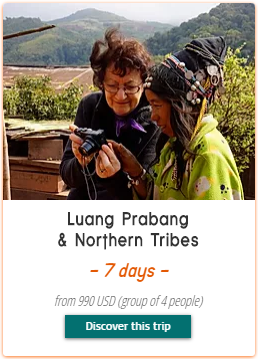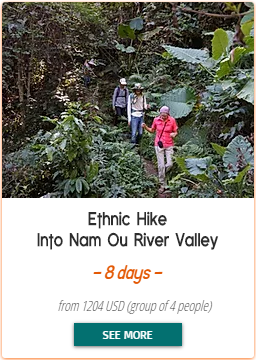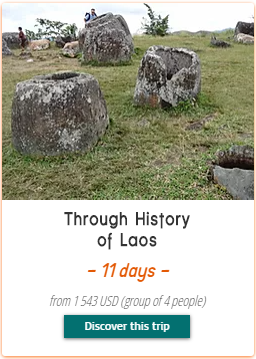Visit Luang Prabang by its tiny streets
- Charly Renaudin

- Aug 23, 2019
- 6 min read
Updated: Jul 24, 2020
Luang Prabang is an amazing city. Its architecture and temples deserve to be explored for at least a day. But how do you visit the city without going through the main roads? How to explore it by avoiding the flow of tourists? The answer is simple: by strolling through its tiny alleys. Luang Prabang is full of secret streets and discreet passages abandoned by tourists. In this article, we invite you to visit them, and discover a village way of living isolated from the hustle of the city. Don’t worry, you won’t get lost! We have prepared you a detailed itinerary. Enjoy your walk !

Few details about the itinerary
All the roads in the itinerary are public, no restriction to go through them.
Some places require entry fees, such as Mount Phousi, Wat Xieng Thong and the Royal Palace.
You can cross the courts of pagodas for free. On the other hand, you will be asked to pay between 10,000 and 20,000 kips to enter inside the temples (hours 06h-18h).
The itinerary is 5.3 km long; you have to plan a full day to complete it taking your time to make the different visits.
You will visit temples, so dress accordingly. Knees and shoulders covered. For ladies, necklines prohibited. You will also have to take off your shoes regularly.
This itinerary was designed to start at the morning market around 07am or 08am and end at the night market which takes place from 5pm to 10pm.
We recommend avoiding Mount Phousi at sunset because it is crowded.
List of the must-do that you will visit :
Main temples of the city: Wat May, Wat Xieng Thong, Wat Sene, Wat Visoun
Former Royal Palace
Mount Phousi (360 ° panorama above the city)
Morning and night markets
Traditional Arts and Ethnics Center (TAEC)
Stroll along the Mekong and Nam Khan river
UNESCO Garden
The itinerary in details

The route starts at the morning market located next to the former Royal Palace.
Around 07am or 08am, you will have the chance to contemplate it while it’s busy. You will discover a village lifestyle away from the flow of tourism. And above all, you can see some exotic products and typical Lao street food.
Continue strolling through the market streets to reach the Wat May temple (10,000 kips).
This is one of the most beautiful pagoda in the city. It was built by King Anourout at the end of the 18th century and was enlarged in the 19th century. Its restoration gave him his final name of "New Monastery". It particularly important because it is where the golden Buddha is exposed during the Lao New Year. Believers come to worship him.
Exit the temple to reach the main street, then turn left. Walk 150m to reach the entrance of the former royal palace, today national museum. (30 000 kips, 08h-11h / 1.30am-4pm).
Built in 1904 for King Sisavang Vong it symbolizes the blend of traditional Lao and French colonial style. With 7 rooms to visit, plan to spend at least 1:30 hour to explore this monument. The magnificent pagoda houses the golden Buddha in normal times.

Leaving the royal palace, take on your left. Then, continue straight until you reach a small alley on your left. Enter to access Heuan Chanh.
You can discover a large traditional wooden house, placed on stilts. In the middle of a garden, the atmosphere is peaceful. You can visit the museum promoting Laotian arts, heritage and crafts (50,000 kips).
Return to the alley and you will see a small gate on your right (before the stairs). You will arrive in the courtyard of the temple Wat Xiengmouane Vajiramangalaram. When leaving, take right. You are in the middle street between the main one and the Mekong.

After 70m walking, take an alley on your left to reach the Mekong. Stroll along the river and enjoy the calm of its banks.
Many restaurants with terraces offer superb views. You can take time to enjoy a coffee or a fresh fruit juice while contemplating the slow boats of the Mekong.
Eat or drink nearby:
- Mekong Sunset view restaurant (Laotian cuisine with a terrace along the Mekong)
- Calao (traditional and ethnic Laotian cuisine)
- Popolo (Mediterranean cuisine)
- L’éléphant (French cuisine)
- Local restaurant for low budget (facing the Frangipani Spa)
Then, go up by an alley, turn left, and walk to the entrance of Wat Xieng Thong (20,000 kips, 06h-18h).
The "Golden City Monastery" is probably the most splendid temple in Luang Prabang. Built in 1560 by King Setthathirat, it is an architectural reference and one of the high symbols of Buddhism in Laos. Take your time to admire the Buddha, the funerary tank protected by 2 nagas or the paintings telling the legend of Tao Chanthaphanith. Above all, don’t miss the beautiful glass mosaic that represents the tree of enlightenment (bodhi).

After visiting the temple, go down the monumental staircase on the Mekong side. You can descend to the river to enjoy a magnificent view of the mountains. This access is very symbolic, it is where the paper boats are offered to the Mekong during the light festival. Then, continue towards the end of the peninsula. You can then relax in the UNESCO Gardens. From there, admire the view above where the Mekong and the Nam Khan meet. Then, return to Sakkhaline Street, which is the main street.
Eat or drink nearby:
- Banneton (French bakery and restaurant)

Go straight for about 230m to Wat Sibounheuang temple. You will cross the courses of several temples until the pagoda Wat Sene (open all day). The plants and trees in its garden encourage meditation and relaxing.
Wat Sene Souk Haram or "temple of 100,000 treasures" presents superb ocher walls with frescoes of gold (early 18th century). It is surmounted by an impressive three-sided roof.
Eat or drink nearby:
- Bamboo tree Watsene (traditional Laotian cuisine)
After visiting the temple, step out onto the main street and enter a small alley that goes down to the Nam Khan. Walk along the river. Contemplating the water flowing is a national sport. During the day, adults come to check the level of the river, while in the evening the youngest go there to flirt.
Eat or drink nearby:
- Bamboo tree NamKhan (traditional Laotian cuisine)
- Dyen Sabai, cross the bamboo bridge or take a boat (Laotian cuisine, Sindat specialty also called hot pot)
Take a small alley paved with terracotta that goes to the left. It will lead you to Wat Aphay, a small isolated temple in a nice garden. After crossing the place, go down the small stairs and continue straight. Cross a small wooden bridge and you will arrive on Phomathat street.
Cross the street to reach the entrance of the temple Wat Visoun and Wat Aham. You will be greeted by two golden Buddhas sitting cross-legged under the magnificent trees of the awakening. Continue straight to the temple and pass the door on the left. You will see the white and golden stupa "of the big lotus" as well as the oldest pagoda of the city. It is unique in its Khmer-inspired construction.
Wat Aham, or "The Monastery of the Enlightened Heart", was built at the beginning of the 19th century. It was a place dedicated to mediation as well as meeting between animist worship and Buddhist practice.
Wat Visounnarat was built during the reign of King Visounnarat in the 16th century. It represents the first architectural model of Lao temples and is the oldest temple in the city still in use.

Walk along the left side of Visoun temple and go down the small stairs to reach Visounarath street. Take on the right, walk for 50m, and you will see an alley on your right. Get in it. This path leads you to the Dara Market (open during the day).
Continue straight ahead in the extension of the alley from which you exit. You will enter in a small village completely abandoned by tourists.
After a few meters, take on the left following the signs indicating TAEC (25 000 kips, open every day except Monday, 09h-18h).
This cultural center includes a museum. It offers plenty of information about the ethnic groups of Laos. Costumes, instruments, pictures, it is very well fitted for adults as well as kids. Possibility to buy fair ethnic clothing and bags on site.
After the visit, go back on the same way where you come from for few meters. You will see signs to Mount Phousi (20,000 kips, open all the time). You will reach it by the least known entry, with a nice panorama above the surroundings. You are not recommended to go there at sunset. The show is certainly beautiful, but you will not be the only ones to contemplate it.

After having climbed more than 300 steps to the Mount Phousi and admired the panorama, go down towards the temple Wat Sippoutabath. Located between Mount Phousi and the Main Street, the atmosphere there is very peaceful.
From there, a way leads you to the main street where there are many restaurants and the night market (open from 17h to 22h).
You can now enjoy a well-deserved beer !
Eat or drink nearby:
- Maolin (Belgian and local draft beers)
- Coconut garden (Laotian and western cuisine)
- Bouang (Asian/French fusion food)
#buddhism #temple #pagoda #monk #luangprabang #belief #ceremony #architecture #culture #almsgiving #history #colonialarchitecture #wildlife #unesco #buddha #statue #tradition #mustdo #mustseelaos #classic #northernlaos #pakou #pakoucaves #laos #asia #southasia #asian #travellaos #paradise






























Comments